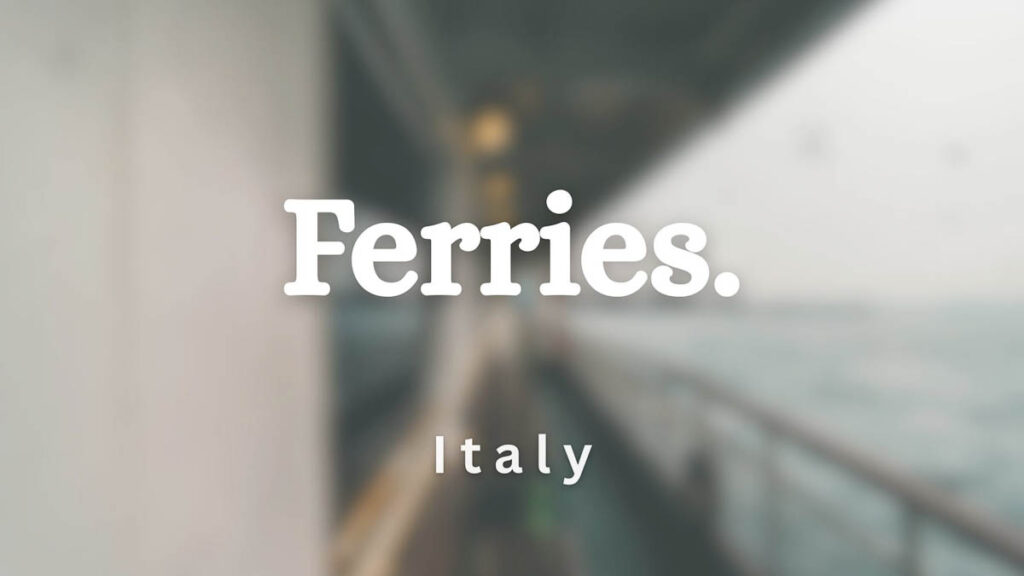
Ferries are an important part of the Italian transport system. They connect the mainland to islands like Sicily and Sardinia, serve smaller islands such as Capri and Elba, and link Italy to neighboring countries across the Mediterranean.
For a full overview of mobility, see our main guide on Transport in Italy.
Table of Contents
- Main ferry companies in Italy
- Main Italian ferry ports
- Domestic ferry routes
- International ferry routes
- How to book a ferry in Italy
- Traveling with or without a car
- Types of ferries
- Practical tips for ferry travel in Italy
- Safety and navigation
- Key takeaways
- See Also
Main ferry companies in Italy
Several operators manage ferry services, but the largest national company is Tirrenia, now part of the Onorato Armatori group. Other well-known operators include Moby Lines, Grandi Navi Veloci (GNV), and SNAV.
These companies cover both domestic and international routes:
- Domestic routes: Sicily, Sardinia, Elba, Ischia, Capri, and Aeolian Islands.
- International routes: Corsica, Spain, France, Albania, Tunisia, and Greece.
Main Italian ferry ports
Italy has many active ferry harbors. The most important are:
- Genoa – Major port for Sardinia, Sicily, Spain, and North Africa.
- Civitavecchia (Rome) – Gateway to Sardinia and Sicily.
- Naples – Main departure point for Capri, Ischia, Procida, and Aeolian Islands.
- Livorno – Services to Sardinia and Corsica.
- Palermo – Connections to mainland Italy and international destinations.
- Cagliari – Main Sardinian hub for ferries to the mainland.
- Venice – Services to Greece, Croatia, and the Adriatic coast.
Smaller harbors like Piombino (for Elba) and Reggio Calabria (for Sicily) are also important for regional connections.
Domestic ferry routes
Sicily
Ferries run from Naples, Genoa, Civitavecchia, and other ports to Palermo, Catania, and Messina. The Strait of Messina crossing (Villa San Giovanni–Messina) is the shortest and most frequent.
Sardinia
Routes from Genoa, Livorno, Civitavecchia, and Naples connect to Cagliari, Olbia, and Porto Torres.
Smaller islands
- Capri, Ischia, Procida – Frequent hydrofoils and ferries from Naples.
- Elba – Short crossing from Piombino.
- Aeolian Islands – Departures mainly from Naples and Milazzo.
International ferry routes
Italy is also connected by sea to several countries:
- Greece – From Ancona, Bari, Brindisi, and Venice to Patras, Igoumenitsa, and Corfu.
- Croatia – Seasonal routes from Venice, Ancona, and Bari to Split, Dubrovnik, and other Adriatic ports.
- Albania – Ferries from Bari and Brindisi to Durrës and Vlora.
- Tunisia – From Genoa, Civitavecchia, and Palermo to Tunis.
- France and Corsica – Ferries from Livorno and Savona to Bastia and Ajaccio.
- Spain – From Civitavecchia and Genoa to Barcelona.
How to book a ferry in Italy
Tickets can be purchased in different ways:
- Online – Through ferry company websites or aggregator sites.
- At the port – Ticket offices are available at major harbors.
- Travel agencies – Many agencies sell ferry tickets alongside flights and trains.
Advance booking is recommended, especially in summer or when traveling with a car.
Traveling with or without a car
Most ferries in Italy allow you to bring a car, motorcycle, or motorhome onboard. This is especially common for long routes to Sardinia and Sicily. On smaller islands like Capri, car transport is restricted during peak tourist months.
For more about driving and parking, see our section on Car transport in Italy.
If you travel without a vehicle, you can board as a foot passenger and rely on local buses, taxis, or scooters once you arrive.
Types of ferries
- Conventional ferries – Larger ships with cabins, bars, and lounges. Suitable for long overnight routes such as mainland–Sardinia.
- Hydrofoils (aliscafi) – High-speed boats used for short crossings, e.g. Naples–Capri. They are faster but carry fewer passengers and no vehicles.
Practical tips for ferry travel in Italy
- Arrive early – For vehicle boarding, check-in is usually 1–2 hours before departure.
- Bring ID – Passports or ID cards are required for boarding, even for domestic trips.
- Book cabins for long routes – Overnight ferries offer cabin options for greater comfort.
- Check seasonal schedules – Many routes operate more frequently in summer and reduce service in winter.
Safety and navigation
Italian ferries are generally reliable, but weather conditions can affect schedules. Strong winds or rough seas may cause delays or cancellations, especially for smaller hydrofoils. Always check departure updates before traveling.
Key takeaways
- Ferries in Italy connect mainland cities with Sicily, Sardinia, and smaller islands, as well as international destinations like Greece, Croatia, and Tunisia.
- Main operators include Tirrenia, Moby, GNV, and SNAV.
- Major ports are Genoa, Naples, Civitavecchia, Livorno, Palermo, Cagliari, and Venice.
- Tickets can be booked online, at ports, or through agencies.
- Options include car ferries for long routes and hydrofoils for short island connections.
Taking ferries is one of the most practical ways to reach Italy’s islands and nearby Mediterranean destinations.
